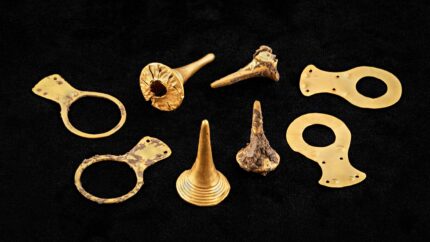Archaeologists have discovered more than a dozen gold artifacts in three Copper Age graves at the Bükkábrány lignite mine in northeast Hungary. About 6,000 years old, these artifacts date to the early centuries of goldsmithing in Europe. The oldest gold jewelry in the world found in the Varna Necropolis, on the Black Sea coast of Bulgaria, dates to between 4,600 and 4,200 B.C., six to two hundred years before the Bükkábrány pieces.
The mine site has been excavated since 2007 when large trunks of swamp cypress from the Miocene era were discovered not petrified, but mummified from having been encased in sand eight million years ago. A natural valley formed by the Csincse river, the area has seen human occupation from the Neolithic to the Middle Ages. There is archaeological evidence of millennia of human settlement, including communities from the middle Copper Age Bodrogkeresztúr culture. The latest excavation unearthed 34 Bodrogkeresztúr-era graves, identified by the characteristic pottery style.
Most of the graves were modestly furnished, but three adult women were buried with prestigious gold ornaments. The gold objects found inside the three graves include hooped and conical pendants. The hoops are tabbed with four holes in each tab. Archaeologists believe they may have originally been mounted onto a headdress. Gold was still extremely rare in the Carpathian Basin at this time and while similar pieces have been discovered at other Copper Age sites, these objects are exceptional for the quality of gold and craftsmanship.
A fourth burial of note did not have any gold artifacts, but contained the remains of an adult man buried with a cracked stone blade, a polished stone axe and copper pick weighing two pounds. The pick was almost certainly not a practical implement. That much metal weight would have been exorbitantly expensive and it was probably more of a leadership symbol like a scepter than a tool.
It is not clear from the style of manufacture whether the objects were made locally or imported. They will be studied further and conserved at the Herman Ottó Museum in Miskolc.
